Overview: this is a short summary of the methodology and preliminary findings from the Occupy Research Demographic and Political Participation Survey (ORGS), followed by frequency tables from the closed-ended questions, followed by links to the full anonymized dataset (including both open-ended and closed-ended questions). Enjoy! If you download the data, please leave a comment to this page and let us know what you do with it.
Introduction
Inspired by the Arab Spring, Occupy Wall Street began on September 17, 2011 in New York City, and led to a broader Occupy movement throughout the U.S. and internationally. The Occupy movement is focused on social and economic inequalities, particularly wealth and power disparities between the wealthiest 1% and everyone else, the 99%.
The Occupy Research General Demographic and Political Participation Survey (ORGS) aimed to gather information about the demographics of participants, as well as forms of civic and political participation in the Occupy movement. ORGS also included questions about forms of communication and media use within the Occupy movement. The survey was designed through a transparent and collaborative process that included Occupy participants and researchers from across the globe.
The survey was conducted from December 7th, 2011, to January 7th, 2012. A total of 5,074 surveys were collected. This summary provides a brief overview of key findings; we expect to release more in-depth analysis over time via the project site, http://occupyresearch.net. Included here are the frequency counts and percents for the closed ended questions.
The survey was conducted by the Occupy Research Network (http://occupyresearch.net), which includes academics, activists, students, community researchers, and others, with support from DataCenter (http://www.datacenter.org), a U.S. based research organization. A list of people involved in this survey is available at http://occupyresearch.wikispaces.com/surveys#People. For more information or if you have questions, please contact owsgeneralsurvey AT gmail.com.
Methodology
We initially hoped to conduct a large number of face to face surveys at Occupy camps, following a simple random sampling method that is detailed in our manual for surveyors (http://bit.ly/OccupyResearchSurveyandGuide), as well as in a webinar presentation used to train surveyors (http://prezi.com/abentbthm65z/occupy-research-survey-training). However, prior to and during the survey period the majority of Occupy camps were raided and shut down by police.
As a result, the ORGS survey team turned to online outreach, where we used a mixed method combining systematic Facebook outreach with snowball sampling via email and social media.
We used an iMacros script to post the survey description and link to 883 Occupy related Facebook groups, using the most comprehensive list of Occupy related Facebook groups available, known as the B.E.S.T. database ( Available at https://docs.google.com/spreadsheet/ccc?key=0An-A-lITWCO8dHJjVlplQklhOWNxR1YzQmZXaWN3TkE#gid=0 ). We also posted the survey to the 505 email addresses publicly associated with Occupy groups (again from the BEST database). Additionally, the site http://occupytogether.org added a link to the survey in the upper right hand corner of their site during the survey period. Finally, members of the ORGS survey team posted the survey information extensively to personal and professional networks, blogs, social media, and via twitter.
Overall, we gathered 5,074 completed surveys, the vast majority of which (5,040, or 99.3%) were completed online.
Of those (4,382) who answered the question “Where did you find the link to this survey,” 57% said via a link from Facebook, 20% from a personal contact, 12% from occupytogether.org, 7.3% from twitter, and 4% from occupyresearch.net.
Limitations
The ORGS sample is non-random and therefore does not have external validity: our findings should not be read as conclusions about the overall Occupy movement. In addition, as an online survey, we can expect our data to be deeply biased to reflect the demographics and political participation characteristics of those with greater levels of Internet access. The survey was in English only, and therefore fails to reflect non-English speakers who may be Occupy participants. The high proportion of respondents who came to the survey via Facebook rather than in other ways also skews results – for example, in the responses to questions about recent Occupy related media use. However, the survey does contain data from several thousand self-identified Occupy movement participants, and will be of interest to anyone seeking to better understand the Occupy movement across multiple sites.
Key Findings
Involvement in Occupy Wall Street
The vast majority of people we surveyed (91.3%) report performing various activities related to the Occupy movement.
- The most common activities are: posting on Facebook (74.3%) and holding face-to-face conversations about the movement (72.7%), followed by signing petitions (59.7%) and marching in protests (49.3%).
- Others donate money (38.8%), food, or needed goods to a camp (23.7%); make phone calls to elected officials (23.7%); or organize events or actions (18.7%).
- About a fifth of participants write blog posts (18.3%), while 7.9% make video about Occupy.
- A smaller, core group of participants report getting arrested (2.3%).
Engagement with the movement in the public space is a prominent feature of participants’ experience in the Occupy movement.
- 63.3% have been to a camp.
- Most attend General Assemblies (68.7%) and participate in protests organized at camps (68.6%).
- More than a third volunteer to provide food or services (41.1%), take part in workshops or events (39.5%), or participate in working groups (38%).
- 17.2% lived or slept in camps, and 3.6% got arrested at camps.
Organizational Affiliation and Civic Engagement
The majority of survey respondents (86.8%) self-identify as participants in OWS, and more than half of them (59%) have previously been involved in other social movements.
Survey respondents are engaged in a wide range of civic and political organizations, representing the variety of civic cultures and interests characteristic of the U.S. population. However, they tend to have distinct degrees of involvement in particular organizations.
- The majority (57%) belonge to non-profit organizations, and most respondents declare that they are active in nonprofits.
- Although 52.5% belong to political parties, only 21.6% of respondents are actively involved.
- Social justice groups and other volunteer associations are also preferred sites for respondents’ active involvement with their communities. Other sites of active community engagement include professional associations, cultural groups, churches or religious organizations, and affinity groups.
There are many ways in which survey respondents have taken civic action in their communities over the past year:
- The overwhelming majority (91%) have signed petitions and boycotted or deliberately bought certain products for political, ethical or environmental reasons (89.9%).
- More than two thirds have contacted or attempted to contact a politician or civil servant to express their views (77%) , and 67.7% have donated money or raised funds for a social or political activity.
- Almost two thirds have taken part in demonstrations (66.6%); joined an Internet political forum or discussion group (65%); or attended a political meeting or rally in the last year (62.5%).
- 40% have contacted or appeared in the media to express their views.
The overwhelming majority of participants in our survey are also actively involved in electoral politics.
- 87.3 % voted in the 2008 presidential elections, and
- 81% % plan to vote in the November elections.
However, political preferences of survey participants are mostly fragmented, and include an important number of independents.
- More than a third declare that they are independent or not identified with any political party (38.4%), while almost an equal number declare that they are sympathizers with the Democratic party (37.9%).
- The political views the rest of participants are widely diverse, consisting of many other parties and political causes (22.6%), and a small minority identifying with the Republican party (1.1%)
We found that most respondents (76.6%) voted for Barack Obama in the 2008 presidential elections. However, voting intentions for the 2012 presidential election appeared divided and in flux.
- 45% of participants plan to vote for the Democratic candidate,
- 35.9% are undecided, and
- 19.1% plan to vote for other candidates, including the candidate of the Republican party (1.9%).
Media Use
Among those who answered questions about usage of different types of media for news and information about the Occupy movement, survey respondents are heavy users of social media (as to be expected given the proportion of survey respondents arriving via a link from Facebook). Print and broadcast media were not used as frequently or as widely by survey respondents.
- The majority (63.7%) report using Facebook in the past 24 hours,
- Nearly half (43.8%) used Occupy movement websites in the past 24 hours, while a similar percent (42.6%) used word of mouth for Occupy news and information in the past 24 hours.
- 41.5% used email, while a third used YouTube (29.2%).
- Just a quarter (23.8%) used newspapers, blogs (23.7%), or Twitter (23.3%).
- A fifth (19.2%) used a livestreaming video site, TV (17.3%), or radio (17.3%).
Who completed the survey
- The majority (85.7%) of the people who filled out the survey are in the USA, while 14.3% live abroad.
- More than half of the survey respondents (52.9%) identify as women, 43.7% as men, and about 1% (50) as transgender. In regards to sexual identity, the majority identify as heterosexual/straight (76.4%), while 15.5% identify as LGBTQ.
- The average age of survey respondents is 42. Almost half (45%) are between the ages of 25 and 44, followed by those between 44 and 64. Two out of ten are under 25 or over 65.
- 80.8% identify as white. There is a diversity of other races/ethnicities including Latino/a (5.3%), Asian/Pacific Islander (5.4%), Native American (5.3%), and African American (2.9%).
- Almost half (49.2%) of the respondents identify as working or lower middle class. More than half (54.4%) report that they earn less than $50,000. Just under one third are employed full time. 8.6% report being unemployed, and 7.6% say they are underemployed. 17.6% are students.
- Over one quarter (29.8%) have graduate degrees, followed by those that completed college (26%) or some college (23%).
- Almost half (47.5%) of the respondents are renters, and 41.3% are homeowners. 8.6% say they live with their parents.
- Respondents are fairly evenly split between being married/in a partnership, and single. 17.9% report having one or more children, and almost half (47.2%) say they support at least one person with their income.
Frequency Tables
Part 1. Occupy Participation
| Have you ever been to an Occupy camp? (n=5070) |
|
|
|
N |
Percent |
| Yes |
3208 |
63.3 |
| No |
1862 |
36.7 |
| Frequency of going to camp (n=3132) |
|
|
|
N |
Percent |
| I live in the camp |
109 |
3.5 |
| I’ve been many times |
1109 |
35.4 |
| I’ve been a few times |
1302 |
41.6 |
| I’ve been once |
612 |
19.5 |
| Type of activities participated in during visits to Occupy camps. (n=3208) |
|
|
|
N |
Percent |
| Attended a General Assembly |
2203 |
68.7 |
| Marched in a protest |
2202 |
68.6 |
| Volunteered to provide food or services to people at the camp |
1320 |
41.1 |
| Participated in workshops or events hosted at the camp |
1266 |
39.5 |
| Taken part in a Working Group |
1219 |
38.0 |
| Slept in an Occupy camp |
552 |
17.2 |
| Got arrested |
114 |
3.6 |
| Other (please describe activities, one per line): |
837 |
26.1 |
| Types of activities participated in related to the Occupy movement |
|
|
|
N |
Percent |
| Posted about Occupy via Facebook, Twitter, or other social m |
3770 |
74.3 |
| Had a face to face discussion about Occupy |
3689 |
72.7 |
| Signed a petition |
3027 |
59.7 |
| Marched in a protest |
2503 |
49.3 |
| Donated money, food, or needed goods to a camp |
1968 |
38.8 |
| Made phone calls to elected officials |
1203 |
23.7 |
| Organized an event or action |
948 |
18.7 |
| Wrote a blog post about Occupy |
930 |
18.3 |
| No, I have not participated in any activity related to the O |
439 |
8.7 |
| Made a video about Occupy |
399 |
7.9 |
| Got arrested |
116 |
2.3 |
| Other (write in, one per line): |
747 |
14.7 |
Part 2. Movement Participation
Organizational Affiliation and Civic Engagement
| If the Occupy movement the first movement respondents participated in (n=4865) |
|
|
|
N |
Percent |
| Yes |
1347 |
27.7 |
| No |
2874 |
59.1 |
| I don’t consider myself a participant |
644 |
13.2 |
| Participation and level of participation different kinds of groups or associations. |
|
|
|
|
|
|
|
N |
belong, actively participate |
belong but don’t actively participate |
used to belong, do not any more |
have never belonged |
can’t choose/don’t know |
| Nonprofit Organization |
4537 |
42.5 |
14.6 |
17.9 |
22.8 |
2.1 |
| Another voluntary association |
4296 |
29.4 |
10.4 |
24.8 |
27.8 |
7.5 |
| Social Justice Organization |
4452 |
28.8 |
14.4 |
11.8 |
40.0 |
5.1 |
| Political Party |
4592 |
21.6 |
30.9 |
16.3 |
28.8 |
2.4 |
| Non-government Organization |
4361 |
21.0 |
10.0 |
12.2 |
45.9 |
10.9 |
| Professional Association |
4410 |
19.6 |
18.2 |
16.0 |
41.6 |
4.6 |
| Cultural Groups |
4314 |
19.5 |
10.7 |
13.4 |
48.5 |
7.9 |
| Affinity Group |
4295 |
14.6 |
5.4 |
8.6 |
48.5 |
22.8 |
| Church or Religious Organization |
4441 |
14.6 |
8.3 |
37.0 |
38.4 |
1.7 |
| Sports group or teams |
4296 |
8.9 |
3.7 |
36.9 |
46.4 |
4.0 |
| Labor Union |
4479 |
8.0 |
8.1 |
20.9 |
61.3 |
1.7 |
| Business Association |
4288 |
7.8 |
6.4 |
12.2 |
67.5 |
6.1 |
| Worker Center |
4227 |
2.0 |
1.6 |
4.1 |
78.9 |
13.5 |
| Participation in different forms of political and social |
|
|
|
|
|
|
|
|
|
|
|
|
|
|
N |
In the past year |
Over a year ago |
Not done it but may |
Would never do it |
Can’t choose/don’t know |
| Signed a petition |
4623 |
91.1 |
5.9 |
1.9 |
.7 |
.4 |
| Boycotted, or deliberately bought, certain products for political, ethical or environmental reasons |
4593 |
89.9 |
4.3 |
4.1 |
.8 |
.8 |
| Contacted, or attempted to contact, a politician or a civil servant to express your views |
4575 |
77.1 |
10.1 |
10.6 |
1.5 |
.7 |
| Donated money or raised funds for a social or political activity |
4545 |
67.7 |
12.9 |
14.6 |
3.0 |
1.8 |
| Took part in a demonstration |
4556 |
66.6 |
15.3 |
15.5 |
1.6 |
.9 |
| Joined an Internet political forum or discussion group |
4543 |
65.1 |
6.8 |
22.7 |
2.8 |
2.6 |
| Attended a political meeting or rally |
4547 |
62.5 |
18.9 |
15.5 |
2.2 |
1.0 |
| Contacted or appeared in the media to express your views |
4479 |
40.3 |
16.1 |
33.7 |
7.1 |
2.7 |
Part 3. Political Preferences
|
[US Respondents =3,652]
Which of the following political parties do you identify with most closely?
|
|
|
|
N
|
Percent
|
|
Independents/ Do not identify with any party
|
1401
|
38.4
|
|
Democratic
|
1383
|
37.9
|
|
Republican
|
40
|
1.1
|
|
Other
|
828
|
22.6
|
| [International Respondents] Political Party affiliation (n=579) |
|
|
|
N |
Percent |
| I associate with the following political party (list forthcoming) |
283 |
48.9 |
| I do not identify with any party |
296 |
51.1 |
| [US Respondents] Candidate voted for in the 2008 presidential election? (n=3661) |
|
|
|
N |
Percent |
| Other candidate (please specify) |
249 |
6.8 |
| Barack Obama |
2805 |
76.6 |
| John McCain |
76 |
2.1 |
| Voted but decline to state candidate |
64 |
1.7 |
| Was too young to vote |
122 |
3.3 |
| Wasn’t eligible to vote |
85 |
2.3 |
| Did not vote |
260 |
7.1 |
| Total |
3661 |
100.0 |
| [International Respondents] If voted in most recent election (n=586) |
|
|
|
N |
Percent |
| Yes, I voted for: (list forthcoming) |
450 |
76.8 |
| No, didn’t vote |
84 |
14.3 |
| Was too young to vote |
17 |
2.9 |
| Wasn’t eligible to vote for other reasons |
35 |
6.0 |
| [US Respondents] Plan to vote in the 2012 presidential election. (n=3652) |
|
|
|
N |
Percent |
| Yes |
2960 |
81.1 |
| No |
148 |
4.1 |
| Undecided |
443 |
12.1 |
| Won’t be eligible to vote |
101 |
2.8 |
| Total |
3652 |
100.0 |
|
[US Respondents n=3,487]
If you plan to vote, for whom do you expect to vote?
|
|
|
|
N
|
Percent
|
|
Democratic candidate
|
1569
|
45
|
|
Undecided
|
1251
|
35.9
|
|
Republican
|
66
|
1.9
|
|
Other
|
601
|
17.2
|
| [International Respondents] Plans to vote in the next national election (n-586) |
|
|
|
N |
Percent |
| Yes, I plan to vote for: (list forthcoming) |
398 |
67.9 |
| No |
71 |
12.1 |
| Undecided |
98 |
16.7 |
| Won’t be eligible to vote |
19 |
3.2 |
Part 4 Media Use and Occupy
| Usage of different types of sources for news and information about the Occupy movement. |
|
|
|
|
|
|
|
N |
In the past 24 hours |
In the past week |
In the past month |
More than a month ago |
Never |
| Facebook |
4383 |
63.7 |
13.3 |
7.7 |
2.5 |
12.8 |
| Websites of the Occupy Movement |
4376 |
43.8 |
23.1 |
15.7 |
5.8 |
11.7 |
| Word of mouth |
4397 |
42.6 |
28.5 |
16.7 |
5.8 |
6.3 |
| Email |
4399 |
41.5 |
21.1 |
14.3 |
5.8 |
17.4 |
| YouTube |
4316 |
29.2 |
24.4 |
19.5 |
7.2 |
19.8 |
| National or international Newspaper |
4270 |
23.8 |
26.3 |
19.6 |
9.0 |
21.2 |
| Blogs |
4225 |
23.7 |
24.2 |
18.3 |
7.3 |
26.5 |
| Twitter |
4202 |
23.3 |
9.4 |
9.5 |
4.6 |
53.2 |
| Local Newspaper |
4285 |
20.2 |
23.6 |
21.7 |
11.3 |
23.1 |
| Livestreaming video site |
4237 |
19.2 |
21.9 |
23.1 |
9.1 |
26.7 |
| National or International Television |
4163 |
17.3 |
19.4 |
19.8 |
11.2 |
32.2 |
| National or international Radio |
4192 |
17.3 |
19.5 |
17.8 |
9.5 |
35.8 |
| Discussions at Occupy camps or face to face groups |
4332 |
17.2 |
15.9 |
21.8 |
16.9 |
28.2 |
| Local Radio |
4247 |
16.8 |
18.1 |
16.7 |
11.1 |
37.3 |
| Local Television |
4196 |
12.2 |
15.4 |
19.4 |
14.0 |
39.0 |
| Chat rooms / IRC |
4128 |
7.0 |
5.5 |
6.8 |
7.2 |
73.6 |
| Tumblr |
4125 |
6.0 |
7.4 |
10.0 |
5.3 |
71.3 |
| Other |
1382 |
14.0 |
4.1 |
4.5 |
2.2 |
75.1 |
‘
Demographics
Gender / Sexual Identity
| Gender (Valid responses 4,307) |
|
|
|
N |
Percent |
| Female |
2277 |
52.9 |
| Male |
1881 |
43.7 |
| Transgender |
45 |
1.0 |
| Decline to state |
96 |
2.2 |
| Marked multiple responses |
8 |
0.2 |
| Sexual identity (n=4,225) |
|
|
|
N |
Percent |
| Heterosexual/Straight |
3229 |
76.4 |
| Lesbian/Gay/Bisexual/Queer |
653 |
15.5 |
| Decline to state |
299 |
7.1 |
| Marked multiple responses |
44 |
1.0 |
Age
| Age (Check all that apply) |
|
|
|
N |
Percent |
| Under 18 |
41 |
1.0 |
| 18-24 |
529 |
12.5 |
| 25-44 |
1910 |
45.0 |
| 45-64 |
1437 |
33.9 |
| 65 and over |
324 |
7.6 |
| Total |
4241 |
100.0 |
Race / Ethnicity
| [US respondents] Your race/ethnicity –(Check all that apply) |
|
|
|
N |
Percent |
| White/Caucasian |
3002 |
80.8 |
| Latino/Latina |
196 |
5.3 |
| Native American/Indigenous |
160 |
4.3 |
| Asian |
106 |
2.9 |
| Black, African, or African-American |
109 |
2.9 |
| South Asian |
41 |
1.1 |
| Arab, Southwest Asian or North African |
28 |
.8 |
| Pacific Islander |
25 |
.7 |
| Southeast Asian |
15 |
.4 |
| Biracial/Multiracial/Mixed race |
165 |
4.4 |
| Decline to state |
171 |
4.6 |
Employment / Income / Class
| Employment Status in last month (Check all that apply) |
|
|
|
N |
Percent |
| Employed full-time |
1605 |
31.6 |
| Student |
894 |
17.6 |
| Self-employed |
749 |
14.8 |
| Part-time |
729 |
14.4 |
| Unemployed |
438 |
8.6 |
| Retired |
399 |
7.9 |
| Under-Employed |
388 |
7.6 |
| Disabled |
269 |
5.3 |
| Full-time homemaker |
173 |
3.4 |
| Veteran |
133 |
2.6 |
| Temp/Per-diem |
67 |
1.3 |
| Seasonal |
63 |
1.2 |
| Armed Services (active service) |
12 |
.2 |
| Other (please specify) |
280 |
5.5 |
| [US respondents] What is your annual household income in U.S. dollars? (n=3641) |
|
|
|
N |
Percent |
| No income |
133 |
3.7 |
| 1-9,999 |
253 |
6.9 |
| 10,000-19,999 |
473 |
13.0 |
| 20,000-29,999 |
427 |
11.7 |
| 30,000-39,999 |
370 |
10.2 |
| 40,000-49,999 |
323 |
8.9 |
| 50,000-59,999 |
257 |
7.1 |
| 60,000-69,999 |
195 |
5.4 |
| 70,000-79,999 |
194 |
5.3 |
| 80,000-89,999 |
149 |
4.1 |
| 90,000-99,999 |
109 |
3.0 |
| 100,000+ |
458 |
12.6 |
| Decline to state |
300 |
8.2 |
| Class Identity |
|
|
|
N |
Percent |
| Working class |
1192 |
29.7 |
| Lower middle class |
784 |
19.5 |
| Middle class |
1489 |
37.1 |
| Upper middle class |
503 |
12.5 |
| Upper class |
50 |
1.2 |
| Total |
4018 |
100.0 |
Education
| [US respondents] Educational Attainment (n=3668) |
|
|
|
N |
Percent |
| No formal education |
1 |
.0 |
| Grade school (grades 1-8) |
7 |
.2 |
| Some high school (9-12), no degree |
54 |
1.5 |
| High school, completed diploma/GED |
162 |
4.4 |
| Some college, no degree |
842 |
23.0 |
| Associates degree |
240 |
6.5 |
| College degree (BA, BS, AB, etc.) |
955 |
26.0 |
| Graduate or professional school, no degree |
314 |
8.6 |
| Graduate or professional degree (MA, MS, MD, JD, PhD) |
1093 |
29.8 |
| Total |
3668 |
100.0 |
Motivations
Respondents gave 0 to 3 reasons for participating or for not participating or both.
|
|
Number of Reasons Why I Participate |
|
|
|
|
0 |
1 |
2 |
3 |
TOTAL |
|
| Number of Reasons Why Not |
0 |
911 |
42 |
59 |
1901 |
2913 |
|
| 1 |
36 |
19 |
27 |
199 |
281 |
|
| 2 |
38 |
17 |
29 |
256 |
340 |
|
| 3 |
198 |
12 |
24 |
1305 |
1539 |
|
|
TOTAL |
1183 |
90 |
139 |
3661 |
5073 |
|
|
|
|
|
|
|
|
|
|
|
|
|
|
|
|
|
|
|
Number of Reasons Why I Participate |
|
|
|
|
0 |
1 |
2 |
3 |
Total |
|
| Reasons Why No |
0 |
18% |
1% |
1% |
37% |
57% |
|
| 1 |
1% |
0% |
1% |
4% |
6% |
|
| 2 |
1% |
0% |
1% |
5% |
7% |
|
| 3 |
4% |
0% |
0% |
26% |
30% |
|
|
Total |
23% |
2% |
3% |
72% |
100% |
|
|
|
|
|
|
|
|
|
|
|
|
|
|
|
|
|
Home/ Housing
| Housing Status (n=4163) |
|
|
|
N |
Percent |
| Renter |
1977 |
47.5 |
| Homeowner |
1721 |
41.3 |
| Live with parents |
358 |
8.6 |
| Homeless |
57 |
1.4 |
| Homeowner – foreclosed |
50 |
1.2 |
| Currently living in U.S. (n=4333) |
|
|
|
N |
Percent |
| Yes |
3715 |
85.7 |
| No |
618 |
14.3 |
Family
| Marital status (n=4311) |
|
|
|
N |
Percent |
| Have partner/Married |
2017 |
46.8 |
| Single |
1639 |
38.0 |
| Divorced |
469 |
10.9 |
| Other (please specify) |
186 |
4.3 |
| Total |
4311 |
100.0 |
| Number of Children Support with Income (under the age of 18) |
|
|
|
|
N |
Percent |
Valid Percent |
| 0 |
1677 |
33.1 |
(treat as no answer) |
| 1 |
466 |
9.2 |
51.3 |
| 2 |
300 |
5.9 |
33.0 |
| 3 |
95 |
1.9 |
10.5 |
| 4 or more |
47 |
.9 |
5.2 |
| No answer |
2489 |
49 |
|
| Number of adults (over 18 years of age) support with income |
|
|
|
N |
Percent |
| 0 |
965 |
19 |
| 1 |
1427 |
28.1 |
| 2 |
785 |
15.5 |
| 3 |
130 |
2.6 |
| 4 or more |
69 |
1 |
| No answer |
1698 |
33.4 |
Survey Implementation
| Is this survey being conducted in a camp or did you follow a link online? |
|
|
|
N |
Percent |
| Followed a link online |
5040 |
99.3 |
| Completed the survey in a camp |
19 |
.4 |
| No Answer |
15 |
.3 |
| Total |
5074 |
100.0 |
| Where did you find the link to this survey? |
|
|
|
N |
Percent |
| Facebook |
2504 |
57.1 |
| From a personal contact |
859 |
19.6 |
| OccupyTogether.org |
532 |
12.1 |
| Twitter |
322 |
7.3 |
| Occupyresearch.net |
165 |
3.8 |
| Total |
4382 |
100.0 |
Links to Data
The following links are to the full, anonymized dataset from ORGS in SPSS format, as a spreadsheet, and as a csv. In addition, there’s a link to the codebook. If you download and work with this data, please leave comments/links here at this post!
Occupy General Survey clean data:
With mnemonic field names:
Answers with text, not with numbers>
Code book
Easy to print version survey: http://bit.ly/openqueshighlightoccupygen


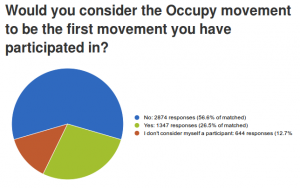

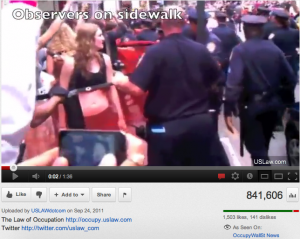






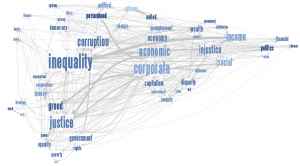
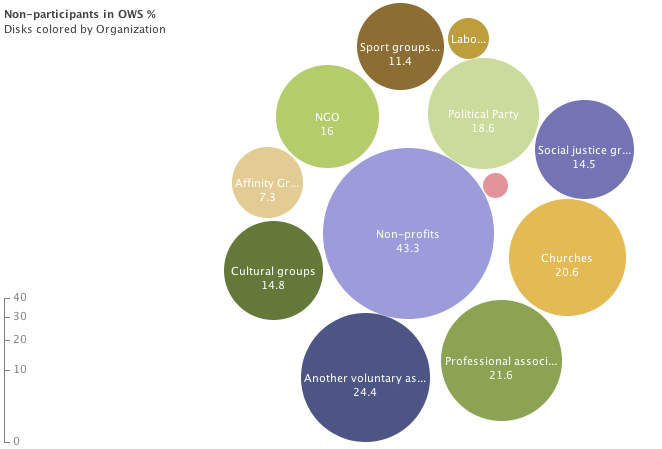
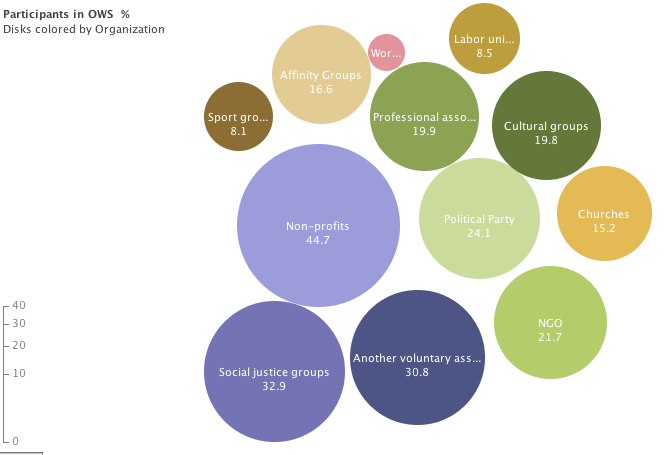


Recent Comments